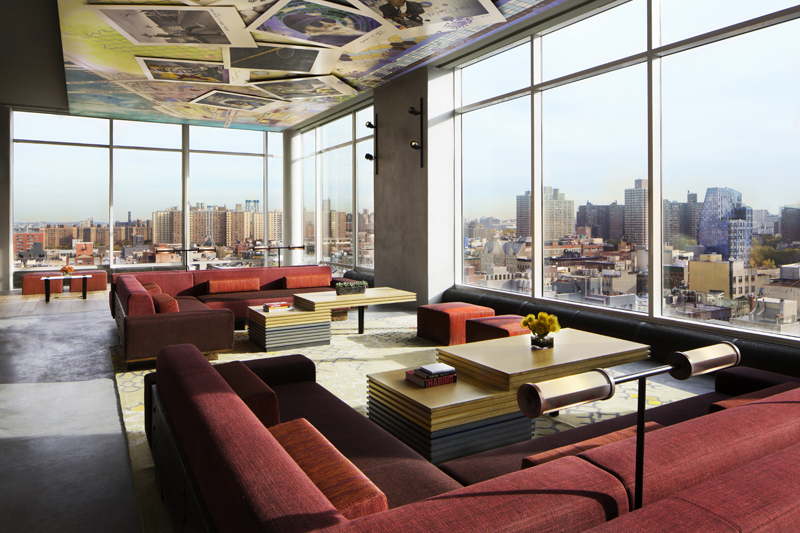It’s all good if you’re in the hotel business.
Occupancy rates in the U.S. are expected to remain at record levels through 2017, according to PKF Hospitality Research|CBRE Hotels, which also projects room rates to increase by 5.5% and 5.8%, respectively, this year and next.
With demand exceeding supply, developers are expected to deliver 103,230 hotel rooms in 865 projects in 2016, according to the latest Comprehensive Pipeline Summary from the market research firm STR.
Through November 2015, the existing supply of hotel rooms nationwide stood at 5,031,859. A total of 457,606 rooms were under construction or in various planning stages.
For all the talk about the rise in demand and construction of luxury hotels, STR foresees the greatest number of hotel rooms—53,725 rooms—being delivered in the “upper midscale” classification, followed by 43,150 “upscale” room deliveries. Conversely, STR estimates that only 15 luxury hotels with 3,468 rooms are expected to open this year.
New York, with an existing supply of 117,367 rooms, leads the nation with 80 hotels and 13,583 rooms under construction, followed by Houston (with 79,255 existing rooms and 6,269 under construction), Dallas (79,572; 4,361), Los Angeles/Long Beach (98,186; 4,240), and Washington, D.C. (107,776; 3,949).
Jan Freitag, STR’s Senior Vice President of Lodging Insights, told USA Today that while room construction was up 21% over a year ago, the 1.5% increase in rooms opening in 2016 would still be below the longer-term annual average of 1.9%
Along from rising customer demand, hotel construction is being driven by room rate appreciation. For example, in Greater Sacramento, Calif., where hotel occupancy rates exceed 77% and where at least 19 hotels are under construction, the average room rates set a record in October at $116.67 per night, up 10.6% from a year earlier, according to PKF Consulting.
However, there’s always the concern that booms will eventually overheat some markets. In Central Dallas, where at least 14 hotels are slated to open between fall 2015 and the end of 2018, investors were bullish about their projects but wondered just how many rooms the market could absorb.
“I can’t remember when we’ve ever had that influx of hotel rooms, certainly in recent history,” said John Crawford, who heads Downtown Dallas Inc., which advocates for downtown development. “And I’ve been in this market for the last 35 years.”
Related Stories
Sustainability | Aug 15, 2023
Carbon management platform offers free carbon emissions assessment for NYC buildings
nZero, developer of a real-time carbon accounting and management platform, is offering free carbon emissions assessments for buildings in New York City. The offer is intended to help building owners prepare for the city’s upcoming Local Law 97 reporting requirements and compliance. This law will soon assess monetary fines for buildings with emissions that are in non-compliance.
Hotel Facilities | Aug 2, 2023
Top 5 markets for hotel construction
According to the United States Construction Pipeline Trend Report by Lodging Econometrics (LE) for Q2 2023, the five markets with the largest hotel construction pipelines are Dallas with a record-high 184 projects/21,501 rooms, Atlanta with 141 projects/17,993 rooms, Phoenix with 119 projects/16,107 rooms, Nashville with 116 projects/15,346 rooms, and Los Angeles with 112 projects/17,797 rooms.
Market Data | Aug 1, 2023
Nonresidential construction spending increases slightly in June
National nonresidential construction spending increased 0.1% in June, according to an Associated Builders and Contractors analysis of data published today by the U.S. Census Bureau. Spending is up 18% over the past 12 months. On a seasonally adjusted annualized basis, nonresidential spending totaled $1.07 trillion in June.
Hotel Facilities | Jul 27, 2023
U.S. hotel construction pipeline remains steady with 5,572 projects in the works
The hotel construction pipeline grew incrementally in Q2 2023 as developers and franchise companies push through short-term challenges while envisioning long-term prospects, according to Lodging Econometrics.
Adaptive Reuse | Jul 27, 2023
Number of U.S. adaptive reuse projects jumps to 122,000 from 77,000
The number of adaptive reuse projects in the pipeline grew to a record 122,000 in 2023 from 77,000 registered last year, according to RentCafe’s annual Adaptive Reuse Report. Of the 122,000 apartments currently undergoing conversion, 45,000 are the result of office repurposing, representing 37% of the total, followed by hotels (23% of future projects).
Hotel Facilities | Jul 26, 2023
Hospitality building construction costs for 2023
Data from Gordian breaks down the average cost per square foot for 15-story hotels, restaurants, fast food restaurants, and movie theaters across 10 U.S. cities: Boston, Chicago, Las Vegas, Los Angeles, Miami, New Orleans, New York, Phoenix, Seattle, and Washington, D.C.
Market Data | Jul 24, 2023
Leading economists call for 2% increase in building construction spending in 2024
Following a 19.7% surge in spending for commercial, institutional, and industrial buildings in 2023, leading construction industry economists expect spending growth to come back to earth in 2024, according to the July 2023 AIA Consensus Construction Forecast Panel.
Hotel Facilities | Jul 21, 2023
In Phoenix, a former motel transforms into a boutique hotel with a midcentury vibe
The Egyptian Motor Hotel’s 48 guest rooms come with midcentury furnishings ranging from egg chairs to Bluetooth speakers that look like Marshall amplifiers.
Sponsored | Fire and Life Safety | Jul 12, 2023
Fire safety considerations for cantilevered buildings [AIA course]
Bold cantilevered designs are prevalent today, as developers and architects strive to maximize space, views, and natural light in buildings. Cantilevered structures, however, present a host of challenges for building teams, according to José R. Rivera, PE, Associate Principal and Director of Plumbing and Fire Protection with Lilker.
Standards | Jun 26, 2023
New Wi-Fi standard boosts indoor navigation, tracking accuracy in buildings
The recently released Wi-Fi standard, IEEE 802.11az enables more refined and accurate indoor location capabilities. As technology manufacturers incorporate the new standard in various devices, it will enable buildings, including malls, arenas, and stadiums, to provide new wayfinding and tracking features.

















